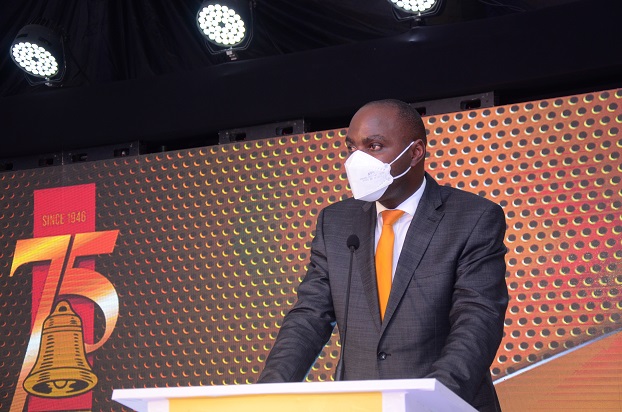Minister of State for Finance, Henry Musasizi.
The Ministry of Finance only released development budgets for four government entities in the first quarter of the current financial year.
We have learnt that only Ministry of Defence, State House, Ministry of Works and Uganda Revenue Authority (URA) benefited from the 596.7 billion Shillings development expenditure releases in the first quarter of financial year 2022/2023.
The first quarter of the financial year runs from July to September and this small development budget release partly explains why many government infrastructure projects have come to a standstill.
The revelation is carried in a detailed report to parliament’s Finance Committee by the Minister of State for Finance, Henry Musasizi explaining the underlying circumstances that informed budget cuts to Ministries, Departments and Agencies in the first quarter of the financial year.
Out of the 14.57 trillion Shillings that the Ministry was expected to release in the first quarter, only 10.25 trillion Shillings was released, creating a deficit of 4.3 trillion.
Now, out of the released 10.25 trillion, the bulk of 5.62 trillion went to debt and interest payment and the remaining 4.67 trillion was released for discretionary expenditure by Ministries, Departments and Agencies (MDAs).
A breakdown of the released funds shows that 1.603 trillion catered for wage, 1.813 trillion for non-wage, 596.7 billion for Development budget and 661.9 billion for arrears.
“There is a zero development release except for: Ministry of Defense, State House, Ministry of Works and URA equipment,” reads a document tabled before Minister Musasizi.
However, the document does not give the specific development budgets received by the entities except Ministry of Works which got 26 billion.
“The Ministry is cognizant of the impact of the Quarter One releases on ongoing projects but borrowing additional resources to bridge the fiscal gap would have adverse social economic consequences. I therefore pray that you remain optimistic. When the macroeconomic fundamentals improve, the resources will be released as appropriated taking into consideration the revenue performance,” Musasizi appeals to the Finance Committee.
Now-Wage Recurrent (Allowances, Fuel, Stationary, Utility Bills and others)
The document accessed by URN also indicates that institutions were provided with 10% of the Quarter One work plan except for the Ministry of Defence, State House, URA, Parliament and Judiciary which received a full release.
Referral Hospitals, Mulago National Referral Hospital, Uganda Cancer Institute, Uganda Heart Institute, Uganda Blood Transfusion Services- UBTS, Missions Abroad, Universities, Ministry of Gender, Labour and Social Development (SAGE) received 80 percent of their non-wage budget for the first quarter.
The entities that received 50 percent of the non-wage budget are Police, Prisons, Internal Security Organization (ISO) and the External Security Organization (ESO), Local Governments and Kampala Capital City Authority (KCCA), all Commissions, Agriculture Institutions, Ministry of Education, Ministry of Health and others.
In the documents before the committee, Minister Musasizi says that the entire arrears allocation of 662 billion for the first quarter was released and 1.603 trillion for wage.
“Regarding Budget Support for this financial year, we have sought the advice of Cabinet and shall bring this to Parliament for approval very soon,” says Musasizi.
Before the current financial year started, Musasizi says the country was experiencing economic shocks like the increase in the prices of essential commodities and services which led to increase in inflation from 2.7% in January 2022 to 6.8% in June 2022 and others.
He notes that the increase in prices was caused by the effect of Covid-19 restrictions across the world which disrupted supply chains, leading to high transport costs, a rapid rise in demand for fuel, raw materials and other goods when global economics were opened, and the Russian-Ukraine conflict.
“As a result of the economic shocks, the Ministry was faced with a challenge of maintaining macroeconomic stability through prudent liquidity management amidst low revenue performance. You will note that government operates a cash based budget and executes the Budget quarterly,” reads part of Musasizi’s document to the Finance Committee.
He says that the under normal circumstances, Ministry would have mobilized the 4.3 trillion first quarter shortfall through borrowing.
He however said that this could not happen since the economy was faced with increasing costs of domestic borrowing, contravention of the structural benchmarks and quantitative assessment criterion which was agreed with the International Monetary Fund –IMF and the subdued aggregate consumer demand which may have an impact on the revenue forecast.
Parliament approved a total budget of 48.1 trillion Shillings for financial year 2022/2023 and out of this, 17 trillion is for interest and debt repayment.
The budget was envisaged to be financed through revenue collections of 25.7 trillion, grants 2.1 trillion and domestic borrowing 7.1 trillion.
The Finance Committee meeting with Ministry officials on Tuesday ended prematurely due to a section of unreadable documents submitted and the committee Chairperson, Keffa Kiwanuka adjourned it to Thursday. The meeting will discuss the specific budget given to each government entity in the first quarter vis-à-vis the appropriated funds, money paid for debt, effects of the budget cuts and others.
The process in the committee follows a directive by Speaker of Parliament, Anita Among to investigate the budget cuts and report back to parliament.
-URN





